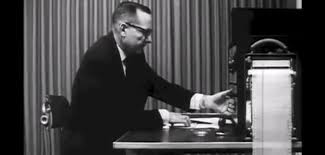If you were ordered to deliver a 400-voltage-shock to another human being by an authority figure, would you do it? Most people would answer “No,” sure of the fact that they would never inflict pain on another person. However, the Milgram Experiment proved otherwise. Why is it that so many individuals obey orders when they are told to, even when they know the orders are wrong? Social psychologist Stanley Milgram researched the power of authority and obedience. Milgram’s experiment on obedience analyzes the psychological processes underlying compliance with orders to commit despicable acts.1
Experiments began in July 1961, three months after the trial of World War II criminal, Adolf Eichmann. He was responsible for ordering the deaths of millions of Jews, but he said he was “just following orders.” He claimed that he did it simply because he was told to. This made Milgram question the power of authority. He questioned, “Could it be that Eichmann and his million accomplices in the Holocaust were just following orders? Could we call them all accomplices?” Throughout history soldiers have followed orders to murder innocent people. So many examples include the Nazi’s killing the Jews, the Turkish slaughter of the Armenians, and the Serbian killings of both Bosnian and Kosovar Muslims. We understand that these were terrible acts and wonder how anyone is capable of committing them. But how many of us would refuse to follow these orders if they came from an authority figure, someone in control, and who obtained power over you?2

The purpose of the experiment was to test whether ordinary people were capable of inflicting harm on others if an authority figure pressured them to do so. Using a newspaper ad, forty men were recruited for the experiment, and each person was paid $4.50. Participants were led to believe that they were assisting in an unrelated experiment, in which they had to administer electric shocks to a “learner.” And they were told that the fake electric shocks were to be gradually increased to fatal levels, if they had been real. Three individuals took part in each session: the “experimenter” (in charge to the session), the “teacher” (the volunteer who was misled to believe that they were merely assisting), and the “learner” (an actor and a confederate of the experimenter who pretended to be a volunteer).3

The actor and participant arrived to the session together, and they both drew slips of paper to determine their roles. Each slip of paper said “Teacher,” but the actor claims to have “Learner,” to guarantee that the subject will always be the “Teacher.” Milgram created a shock generator with different shock levels, starting at 30 volts and going all the way up to 450 volts. Each volt level had a label, such as “slight shock,” “moderate shock,” and “Danger: Extreme Shock.” Whenever an incorrect answer was given from the “Learner,” he was given a shock.4 The participant believed that he was delivering real shocks, but the “student” was a confederate in the experiment, and was just pretending to be shocked. As the experiment progressed, the experimenter would hear the student plead to be released or complain of a heart problem. Once it reached 300-volts, the student would demand to stop. The student would refuse to answer anymore questions, the experimenter instructed the participant to treat the silence like an incorrect answer and shock them.5

Most participants would start to feel they needed to stop before the voltages became too high. They would ask if they should continue and the experimenters would tell them specific verbal encouragements. These were given in this order: “Please continue,” and “The experiment requires that you continue,” and “It is absolutely essential that you continue,” or “You have no other choice, you must go on.” If the subject still wanted to stop after all of these verbal encouragements, the experimenter ended the experiment. If they did not choose to stop, it ended after the subject had given the maximum shock three times during the session. Out of the forty participants, twenty-six delivered the maximum shock while fourteen stopped before reaching the higher levels.6

The experimenter used specific prods for any questions the subject may have had. If the subject was worried about the learner wanting to stop, the experimenter replied, “Whether the learner likes it or not, you must go on until he has learned all the word pairs correctly, so please go on.” While most of the participants were agitated at the experimenter, they still followed the orders that were given.7 The participants experienced anxiety from the experiment, and they learned the truth at the end. The researchers explained they used deception. Milgram raised moral questions, such as why did so many of the participants in this experiment perform a seemingly sadistic act when instructed by an authority figure? Milgram came to the conclusion that, “Ordinary people, simply doing their jobs, and without any particular hostility on their part, can become agents in a terrible destructive process. Moreover, even when the destructive effects of their work become patently clear, and they are asked to carry out actions incompatible with fundamental standards of morality, relatively few people have the resources needed to resist authority.” Milgram’s experiment has inspired psychologists around the world to research more about what makes people comply with orders and what makes them question authority.8
- Thomas Blass, The Man Who Shocked the World: The Life and Legacy of Stanley Milgram (Basic Books, 2004), 1-8. ↵
- Stanley Milgram, “Behavioral Study of Obedience,” Journal of Abnormal and Social Psychology, no.1 (1963): 1, accessed May 8, 2019, http://citeseerx.ist.psu.edu/viewdoc/download?doi=10.1.1.424.795&rep=rep1&type=pdf. ↵
- Stanley Milgram, “Behavioral Study of Obedience,” Journal of Abnormal and Social Psychology, no.1 (1963): 1, accessed May 8, 2019, http://citeseerx.ist.psu.edu/viewdoc/download?doi=10.1.1.424.795&rep=rep1&type=pdf. ↵
- R. Brown, “Social Forces in Obedience and Rebellion,” Social Psychology 2, no. 1 (1986): 5. ↵
- Stanley Milgram, “Some Conditions of Obedience and Disobedience to Authority,” Human Relations, no.1 (1965): 57. ↵
- Eugen Tarnow, “Towards the Zero Accident Goal: Assisting the First Officer Moniter and Challenge Captain Errors,” Journal of Aviation/Aerospace Education and Research 10, no. 1 (2000): 30. ↵
- Vladimir Tumanov, “Stanley Milgram and Siegfried Lenz: An Analysis of Deutschstunde in the Framework of Social Psychology,” Neophilologus: International Journal of Modern and Mediaeval Language and Literature, no.1 (2007): 146. ↵
- Stanley Milgram, “Obedience to Authority: An Experimental View,” New York: Harper and Row, no.1 (1974): 15. ↵



33 comments
Shea Slusser
It’s very stomach twisting and eye opening to realize this is reality. This study is very fascinating in the fact that I have always wondered what power a really manipulative, evil and strong leader can have over its followers and why people go to such lengths when they should know that its wrong. Maybe the leader should be the only one in the blame, but to go to lengths as to harm another human is just mind-blowing.
Briley Perkins
This article was very well written and informative. It is shocking that so many of the participants still followed the orders to give them the shock even though they disagreed with it. Many people probably believe that since it is an authority figure giving them the orders, they should follow them since they must know what they are doing. I find it very hard of how someone with power can drive another human to cause harm to another human.
Michael Thompson
I mean, this is super interesting. It really makes you think, who is to blame for the holocaust. Was it all the Nazi’s as a whole, or was it just Hitler, who was demanding the orders to kill. I mean it is clear people will do as there told by an authority figure, even if they know it is wrong. So maybe in hind sight, only the leader should be blamed for when acts of terrorism happen. Because people below them are just doing what the authority figure say.
Jose Maria Llano Aranalde
Thus was a really interesting article to read. I had never heard about this study before. It was really surprising to me that most people would actually shock the other. Just because they were being told by someone else that was in power. Even thought they were being manipulated its interesting to see how people reacted and started to change and do it even if it is wrong.
Malleigh Ebel
I learned about this experiment last year in my Psychology class. It is crazy to think how people can be convinced to do something due to being ordered. I would like to believe I would not be able to do this, being more aware and trained to think critically before complying, but with how they slowly increased the voltage, and the data from the research concludes otherwise.
Gabriella Urrutia
This article was very interesting to read. I had heard about it before but never really knew much about it. It is shocking that so many of the participants still followed the orders to give them the shock even though they disagreed with it. Many people probably believe that since it is an authority figure giving them the orders, they should follow them since they must know what they are doing. When it is compared to people killing others because they were following orders, many of them probably were too afraid not to listen because they knew what would happen if they disobeyed.
Sydney Hardeman
This was an interesting article to read. Personally, I do not think that I could inflict harm on another individual by shocking them. But the results show that majority of the subjects of the experiment shocked the actor to the maximum voltage. I guess that goes to show that out of fear, many people will inflict harm on innocent people from the demand of someone in authority.
Kristina Tijerina
Through reading this article, I learned that Milgram’s experiment was an experiment that tested to see how many people would shock someone at the highest voltage while under extreme authority pressure. I found out that 26 out of the total 40 ended shocking people while under pressure. The article included different pieces of information related to the experiment, and one of the pieces of information that I found interesting was that many people did cruel things simply because they were told to.
Jesus Parker
Interesting read because I had never heard of this experiment. I love reading about experiments such as this and the prison experiment conducted at Harvard. The human mind is a complicated thing and performing experiments such as this one is a necessity to deepen our understanding and knowledge. This experiment also shows how people follow orders without thinking much about it.
Victoria Davis
It had such a great introduction that you just wanted to keep reading. The article was so interesting and something I have never came across before. It gave great information and was so descriptive as to what was happening. The overall research conducted from the experiment was that when there is authority over a person they can just become an instrument in a destructive process.